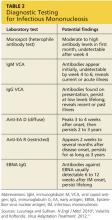DIAGNOSIS
Pertinent information elicited in the patient history should include signs and symptoms, particularly the common triad of pharyngitis, fever, and lymphadenopathy, and possible exposure or sick contacts. Certainly, patients with symptoms of pharyngitis and continued fatigue that are unresolved within 48 to 72 hours should be screened for IM.12,13
In addition to the in-depth history, routine hematologic testing is conducted, as well as serologic testing to confirm the diagnosis. A complete blood count will reveal hyperlymphocytosis (≥ 50%), an elevated white blood cell count (usually ranging from 10,000 to 20,000/mL in most patients), and at least 10% atypical lymphocytes.2,6,8,11 Elevations in liver enzymes are found in 80% to 90% of cases.2,11
Heterophile Antibody Testing
In the symptomatic patient, a positive result on the monospot, a rapid test for heterophile antibodies, is 85% sensitive and 94% specific for IM.5,6,8 Heterophile serology is elevated for the first four weeks of infection, then declines rapidly; thus, this test should not be used beyond one month of symptom onset. Additionally, false-negative monospot test results have been reported in about one-fourth of patients during the first week of symptoms.5,6 For that reason, when suspicion for IM is high but the monospot yields negative results, additional serology with greater sensitivity and specificity is warranted.
Of note, false-negative results on heterophile serology are common in children younger than 12.11,21
EBV Serology
Because IM represents infection with EBV, serologic testing for EBV is accurate, highly specific, and recommended for use when IM is strongly suspected, particularly in infants and younger children. Serologic tests are more reliable, though more expensive and time-consuming, than heterophile antibody testing.11,22
Various EBV serologic tests are used for diagnosis, and it is recommended by the CDC6 that these tests be performed concurrently because the antibody response in EBV is rapid. A blood sample obtained during the acute phase of illness will reveal antibodies representing acute, recent, past, or reactive disease.6
Testing for EBV-specific IgM and IgG antibodies against viral capsid antigen (VCA), early antigen (EA), and the Epstein-Barr virus nuclear antigen proteins (EBNA) is 97% sensitive and 94% specific for a diagnosis of IM.5,11,23 EBV antigen testing can be performed using the following laboratory tests: IgM VCA, IgG VCA, EA IgM, and EBNA IgG. The decision to perform antigen testing is based on timing and onset of symptoms (see Table 25,11 for possible findings from certain tests). Primary EBV infection is indicated by the presence of IgG antibodies against VCA or of IgM antibodies against VCA, in addition to the absence of EBNA antibodies.6,23
As with any laboratory testing, the EBV serology should be correlated with patient presentation and the overall clinical picture. Early antigen testing, it should be noted, is often recommended for patients who have significant and persistent symptoms of IM but who are past the four-week time frame in which heterophile antibody testing is effective.11
A quantitative real-time PCR assay, which detects EBV viral load, can also be used to test blood or plasma for acute infection.11 PCR testing is usually reserved for young children with significant symptoms but negative results on the monospot test; or for patients presenting with IM-like symptoms but having more complex conditions, such as HIV, in which further differentiation of EBV DNA subtypes is needed.24,25
On the next page: Considerations in specific patient populations and complications >>

